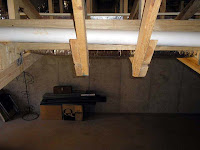
Polybutylene pipe seems to be on many homeowners’ minds lately, judging by the number of questions I receive about it. Since the questions vary widely, I’ll address the most frequently asked ones here.
What is Polybutylene pipe? It is a form of plastic resin that was used extensively in water supply piping from 1978 until 1995. Due to the low cost of the material and ease of installation, polybutylene piping systems were called "the pipe of the future" and were used as a substitute for traditional copper piping.
It is most commonly found in the "Sun Belt" where residential construction was heavy through the 1980's and early-to-mid 90's, but it is also very common in the Mid Atlantic and Pacific Northwest states. The piping was used for underground water mains and interior water supply piping. It was used in approximately 6 million homes.
How can you tell if you have polybutylene pipes? Polybutylene inside your home can be found near the water heater, in basements, crawl spaces, and coming out of walls and floors to feed sinks and toilets. Copper pipes feeding sinks or other fixtures do not rule out the use of polybutylene. Some plumbers used polybutylene throughout the house, but installed short pieces of copper where the pipes come out of the wall and floors.
The most common polybutylene for the interior is gray in color, and the joint connectors look like a plain wedding band. Polybutylene used under ground to bring water to your house is generally blue, but may be gray or black. If it has “PB” on it, then it is polybutylene. Good places to look for exterior polybutylene are at your main shut-off and at your water meter.
What are the problems with polybutylene pipe? Reports indicate that the chlorine in treated water will cause the polybutylene to become brittle; under pressure it will split apart. Polybutylene pipes can leak at anytime, destroying you home and its contents. The problem is there is no warning or a way to tell or predict that the pipe is nearing the time it will fail. It is not possible for a home inspector or a plumber to determine if the polybutylene is about to fail by looking at the outside of the pipe. The deterioration starts from the inside of the pipe, so no evidence is visible from the outside. Failure can happen suddenly without warning.
To date, lawsuits are still outstanding, and class action settlement dollars are pending. To find out more, go to http://www.pbpipe.com/.
The bottom line is that this pipe is known to be a problem. If you have it in your house, you need to know about it. To have this pipe replaced with copper costs about the same as re-carpeting, or a re-roofing. If you are buying a house that has polybutylene, don’t let the fact stop you from buying the house; these things can usually be negotiated to both parties’ advantage.
If you are still not sure if you have polybutylene, call a home inspector.
Remember, for your protection, get a home inspection.


















